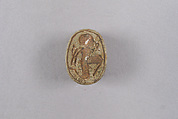Scarab with the Representation of a Libyan Captive
New Kingdom
The base of this scarab shows a man kneeling on his right leg with both arms bound behind his back. This is the traditional way ancient Egyptians depicted their vanquished enemies. Moreover, the prisoner can be identified as a Libyan based on his short wig and the long skirt with bands crossing over his chest. He faces right and in front of his face is a small loop that represents the hieroglyph for protection. This design calls for (royal) protection against one’s enemies and the owner of a seal-amulet with this depiction would be requesting support against threats. He would also hope for the successful victory over such dangers, in analogy with the king who successfully vanquishes his foreign enemies. The protective loop further strengthens the apotropaic function of the design.
Due to rights restrictions, this image cannot be enlarged, viewed at full screen, or downloaded.
This artwork is meant to be viewed from right to left. Scroll left to view more.





